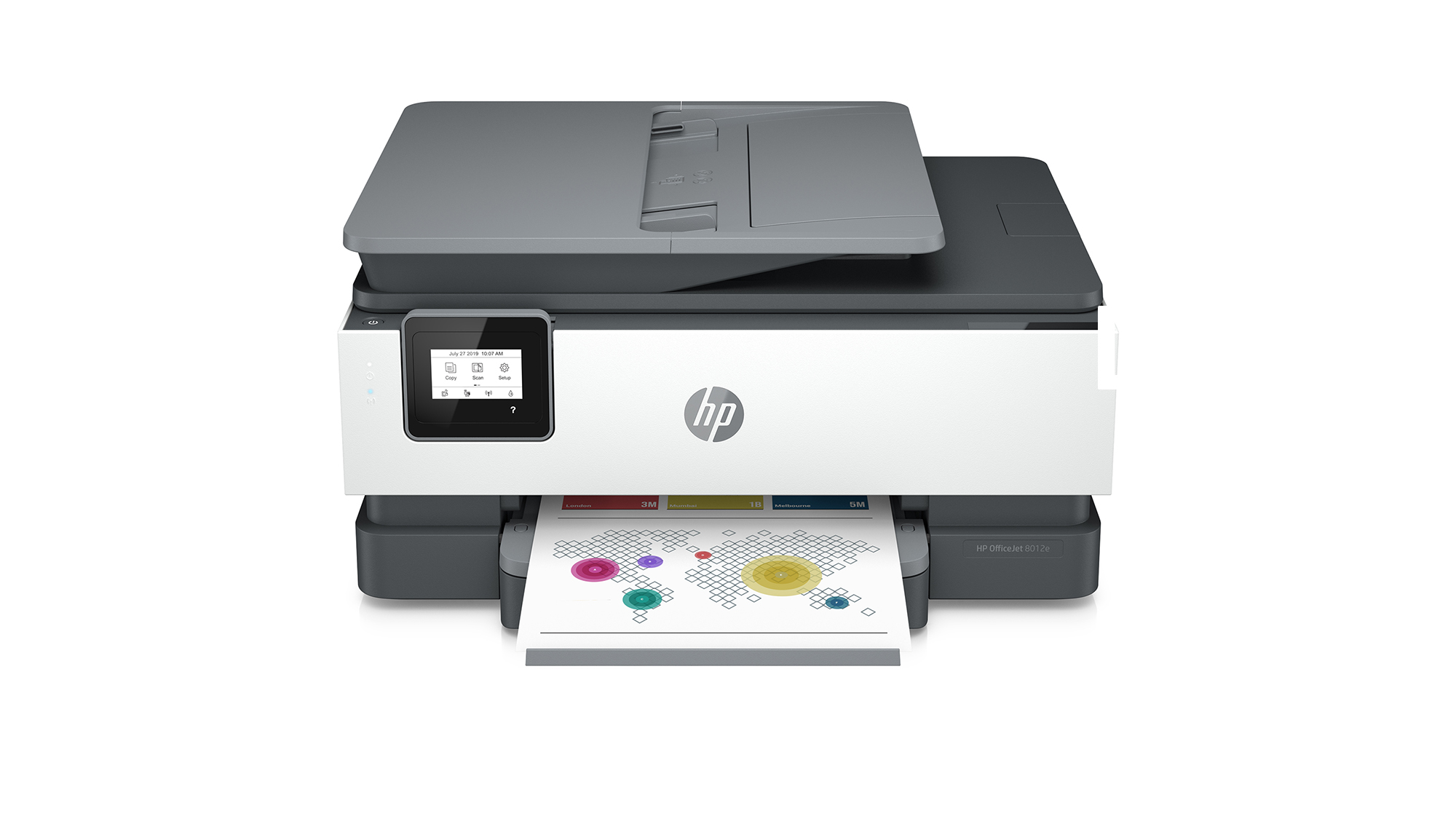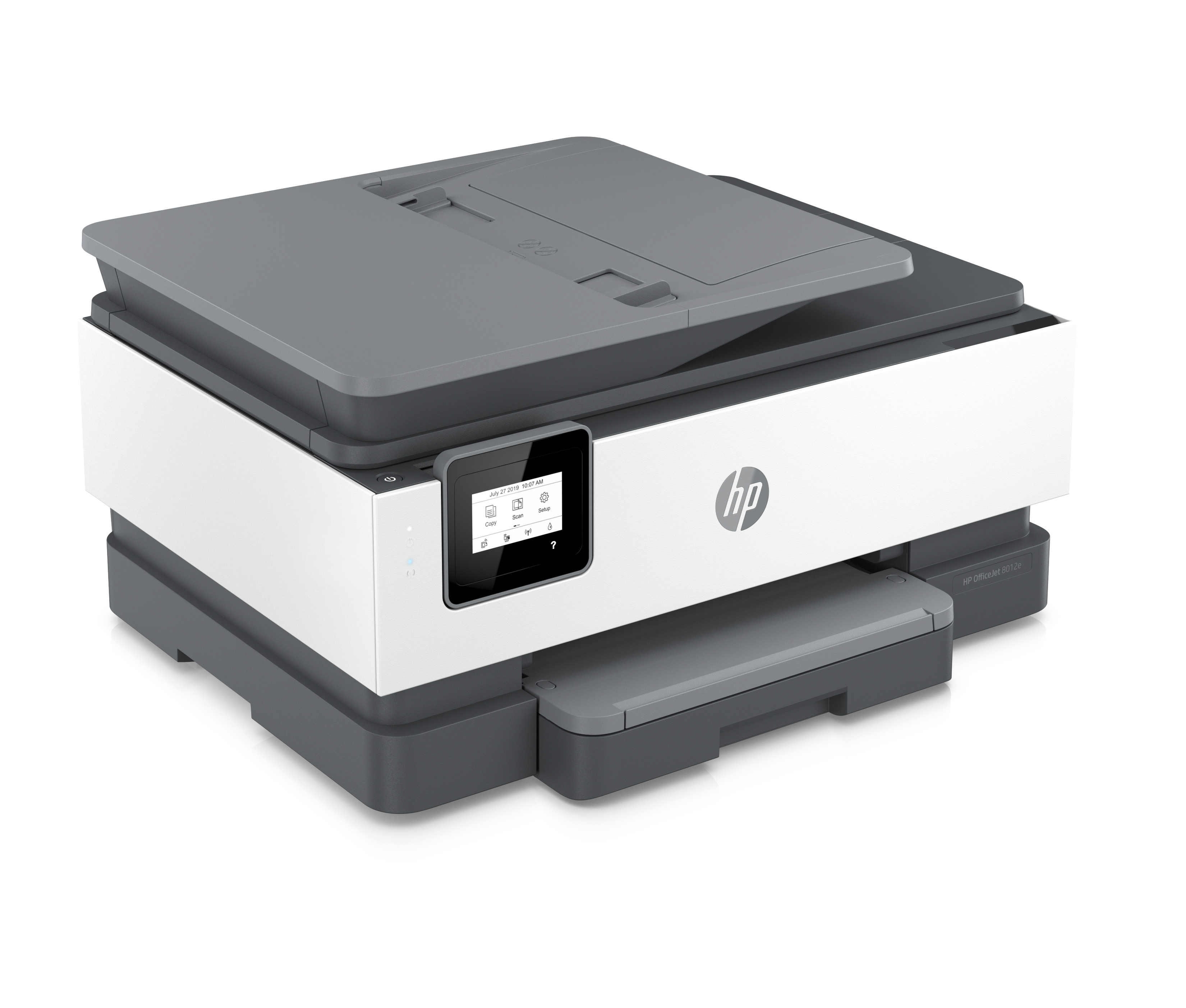HP OfficeJet 8012e review: Home office printing for the more demanding worker
A respectable all-rounder, but no standout unless you subscribe to HP+

-
+
Decent speeds
-
+
Excellent text quality
-
+
Large paper tray and ADF
-
+
Affordable to run on HP+ with Instant Ink
-
-
Pricey to run for non-subscribers
-
-
Photo and copy quality could be better
-
-
Occasional glitches

The HP OfficeJet 8012e is a multi-function printer aimed squarely at the more demanding home office user, though it might also work as a personal printer for the kind of C-suite executive who wants their own dedicated device. The specs are more about all-round competence than high-end printing capabilities or speeds. It claims to print at speeds of up to 20ppm with automatic duplex printing, self-healing Wi-Fi connectivity, a full suite of mobile printing services and integration with HP+ and HP Instant Ink.
The 8012e isn’t a workgroup printer, but HP clearly thinks it’s going to see a lot of action. It has a recommended monthly duty cycle of up to 800 pages – roughly twice what’s expected of most home printers – and not just a 225-page main input tray but also a 25-sheet ADF for the scanner. As far as handling A4 business documents goes, it does it all, though faxing is handled through an online service rather than hardware built into the printer itself.
If you need this kind of printer in your home office, then the OfficeJet 8012e is one of the more stylish options out there. You get a two-tone white and grey body rather than the white and beige of the Envy Inspire line, but it’s a nice enough design with a mix of sharp angles and more gentle curves, even if it’s on the large side. There’s little on the front except two very understated LED indicators and the 5.6cm touchscreen, which controls most of the device’s basic functions. The main paper tray slots into the base at the front, with the 60-page output tray acting as a lid, a flap sliding outwards to give the prints additional support.
Setup couldn’t be much easier. The touchscreen itself asks you to select your language and your region, before prompting you to install the supplied cartridges and fill the paper tray, then running you through the automated print and scan calibration routine. After that you’re sent to HP’s Smart app to find the printer and connect it to your Wi-Fi network. Once that’s done, Windows 11 picks up the printer automatically, or you can install the Smart app on your PC for additional features and controls.
HP’s ahead of some manufacturers with this app-driven approach because it both makes setup easier and adds some genuinely useful features. For instance, you can set up useful shortcuts for scanning and printing to, say, scan in and email a document to yourself or to an office email address. You can also monitor usage, ink levels and perform basic maintenance tasks without firing up your desktop or laptop.
We didn’t see the Officejet 8012e reach HP’s promised headline speeds of 20ppm, but we did see speeds of 14ppm in our 24-page black and white text print tests after the 8.8 seconds it took for the first page to print out. Funnily enough, the page rate didn’t change significantly switching between Normal print mode and the closest thing it has to draft-mode: the ink-saving EconoMode. Print speeds with more complex colour documents were lower, at 6.85ppm after a 22 second wait for the first page. However, the HP proved to be a speedy duplex printer, only dropping to 13.5ppm on double-sided prints.
To put this in perspective, the OfficeJet 8012e is faster than many home office printers, including HP’s own Envy Inspire 7224e, though not quite as speedy in black-and-white as the Epson ET-3850 or Brother MFC-J1010DW, both of which reach speeds of 15ppm or higher. For colour documents and graphics, though, the 8012e is a real contender; nearly 7ppm is good by inkjet standards.

In terms of print quality, the OfficeJet plays to its strengths. Text is sharp, well-defined and black. Colour graphics are cleanly reproduced with subtle gradients and no sign of smearing or banding, and while you’d expect some degradation if you switch to EconoMode, the results aren’t bad at all. True, colour graphics lose a little punch and clarity, but black text still looks great. You really need a pair of strong reading glasses to spot much difference, which is a good indication that it’s not worth worrying about for everyday business use.
One thing the 8012e doesn’t pretend to be is a photo printer. It’s actually quite fast for 8x10 and A4 photo prints, where it took between 90 seconds and just under three minutes to produce the print. On 6x4 prints and A5 photo prints, however, you’re reliant on the guides in the main paper tray, with no dedicated photo paper input, while a 6x4in borderless print took just over 76 seconds to emerge. Many consumer printers will do the job in half that time.
As for the results, they’re fine. Colours are natural and you can pick out smaller details. Definition is reasonably sharp. However, there’s something a bit flat and subdued about the output, especially around reds and pinks, that leaves you feeling vibrant colour and contrast aren’t the 8012e’s thing. It’s one area where it’s beaten by the cheaper Envy Inspire.
The OfficeJet boosts its office credentials by integrating a 25 page ADF on top of the flatbed scanner. It can spit out a black-and-white copy in just 16 seconds or a colour copy in 25, while a full-colour, 300dpi scan takes a mere 22 seconds to come through. It scanned nine colour pages in a minute and a half. Here the Brother and Epson competition is slightly faster, but not to any disastrous extent. The only disappointment is that graphics and photos don’t always come out well, with over-saturation of ink on the page and occasional white lines or even banding effects.
Another area of concern is that paper handling isn’t quite as flawless as you might hope. Twice during testing the printer had to pause midway through for twenty or thirty seconds while rollers spun and the printer rumbled on to no visible effect. This isn’t a huge issue – the prints came out eventually – but it caused us to repeat the tests. The OfficeJet also had issues with our 170gsm photo paper, jamming while loading the sheet on two occasions, and rendering it unusable in one of those.
It's also slightly disappointing that the built-in connectivity doesn’t hit the same level as some of HP’s consumer models. Instead of 801.11ac we get old-school 802.11n, while there’s no Bluetooth for making the initial connection.
For running costs, you’re looking at around £63 for a set of high yield cartridges, with colour print costs of approximately 7.6p per page and black-and-white costs of roughly 3p per page. These aren’t exorbitant, and the use of separate CMYK cartridges means you don’t have to replace all cartridges just because one has run out. All the same, this printer will cost you significantly more to run than Epson’s EcoTank ET-3850, where the ink costs dip well under 1p per page, even for colour.
You could save on your ink costs by signing up for Instant Ink through HP+, and HP includes 6 months in the box. At the time of writing, 300 pages per month would cost you £9.99 inc VAT per month, or £22.49 inc VAT per month for 700.
Overall, the Officejet 8012e comes across as a decent mid-volume home office printer. It’s pretty fast and great for handling text-heavy documents, scanning and copying and, at well under £150 exc VAT, solid value. The problem is that there are other printers out there offering great value, either by beating the HP on performance or by offering much lower running costs without a subscription. The OfficeJet is fast enough and good enough to please its intended audience, but the EcoTank ET-3850 could be a better bet long-term.
HP OfficeJet 8012e specifications
| Format | 1,200 x 1,200dpi A4 inkjet MFP, 1,200 x 1,200dpi flatbed A4 scanner |
| Print speed | Up to 20/10ppm mono/colour |
| Display | 5.58cm LED TFT touchscreen |
| Networking | 802.11n |
| Connectivity | USB |
| Print type | Duplex |
| Tray size | 225-sheet input tray, 60-sheet cards, 10-sheet envelopes |
| Recommended monthly duty cycle | 800 |
| Dimensions | 460 x 511 x 233mm |
| Weight | 8.2kg |
| Warranty | 1yr RTB |
Get the ITPro daily newsletter
Sign up today and you will receive a free copy of our Future Focus 2025 report - the leading guidance on AI, cybersecurity and other IT challenges as per 700+ senior executives
Stuart has been writing about technology for over 25 years, focusing on PC hardware, enterprise technology, education tech, cloud services and video games. Along the way he’s worked extensively with Windows, MacOS, Linux, Android and Chrome OS devices, and tested everything from laptops to laser printers, graphics cards to gaming headsets.
He’s then written about all this stuff – and more – for outlets, including PC Pro, IT Pro, Expert Reviews and The Sunday Times. He’s also written and edited books on Windows, video games and Scratch programming for younger coders. When he’s not fiddling with tech or playing games, you’ll find him working in the garden, walking, reading or watching films.
You can follow Stuart on Twitter at @SATAndrews.
-
 Cleo attack victim list grows as Hertz confirms customer data stolen – and security experts say it won't be the last
Cleo attack victim list grows as Hertz confirms customer data stolen – and security experts say it won't be the lastNews Hertz has confirmed it suffered a data breach as a result of the Cleo zero-day vulnerability in late 2024, with the car rental giant warning that customer data was stolen.
By Ross Kelly Published
-
 Women show more team spirit when it comes to cybersecurity, yet they're still missing out on opportunities
Women show more team spirit when it comes to cybersecurity, yet they're still missing out on opportunitiesNews While they're more likely to believe that responsibility should be shared, women are less likely to get the necessary training
By Emma Woollacott Published
-
 OpenAI wants developers using its new GPT-4.1 models – but how do they compare to Claude and Gemini on coding tasks?
OpenAI wants developers using its new GPT-4.1 models – but how do they compare to Claude and Gemini on coding tasks?News OpenAI says its GPT-4.1 model family offers sizable improvements for coding, but tests show competitors still outperform it in key areas.
By Ross Kelly Published